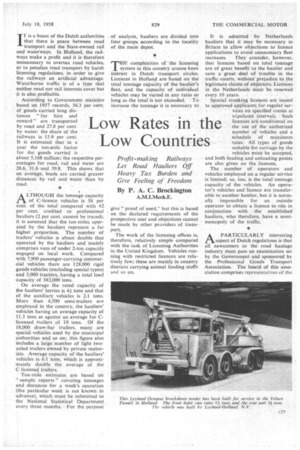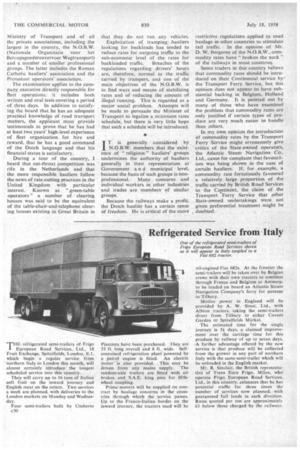w Rates in the Low Countries
Page 67

Page 68

If you've noticed an error in this article please click here to report it so we can fix it.
Profit-making Railways Let Road Hauliers Off Heavy Tax Burden and Give Feeling of Freedom By P. A. C. Brockington A.M.I.Mech.E.
IT is a boast of the Dutch authorities that there is peace between road transport and the State-owned rail and waterways. In Holland, the railways make a profit and it is therefore unnecessary to overtax road vehicles, or to penalize road transport by harsh licensing regulations, in order to give the railways an artificial advantage. Waterborne traffic is of a type that neither road nor rail interests covet but it is also profitable.
According to Government statistics based on 1957 records, 56.3 per cent.. of goods carried long dis tances "for hire and reward" are transported IA by road and 27.8 per cent. • ‘,.../
L
by water: the share of the railways is 15.9 per cent. It is estimated that• in a year the ton-mile factor for the goods carried is about 5,168 million; the respective percentages for road, rail and water are 28.6, 31.6 and 39.8. This shows that on average, loads are carried greater distances by rail and water than by road.
ALTHOUGH the tonnage capacity of C-licence vehicles is 56 per cent. of the total compared with 42 per cent. credited to professional hauliers (2 per cent. cannot be traced), it is assumed that the ton-miles operated by the hauliers represent a far higher proportion. The number of traders' vehicles is about double that operated by the hauliers and mainly comprises vans of under 2-ton capacity engaged on local work. Compared with 7,900 passenger-carrying commercial vehicles there are 128,000 rigid goods vehicles (excluding special types) and 5,000 tractors, having a total load capacity of 382,000 tons.
On average the rated capacity of the hauliers' lorries is 4-1tons and that of the auxiliary vehicles is 2.1 tons. More than 4,500 semi-trailers are employed in the country, the hauliers' vehicles having an average capacity of 11.3 tons as against an average for Clicensed trailers of 10 tons. . Of the 18,000 draw-bar trailers, many are special vehicles used by the municipal authorities and so on; this figure also includes a large number of light twoaxled trailers owned by private motorists. Average capacity of the hauliers' vehicles is 6.1 tons, which is approximately double the average of the C-licensed trailers.
Ton-mile estimates are based on "sample reports" covering tonnages and distances for a week's operation (the particular week is not known in advance), which must be submitted to the National Statistical Department every three months. For the purpose of analysis, hauliers are divided into four groups according to the locality of the main depot.
rr HE complexities of the licensing
system in this country arouse keen interest in Dutchtransport circles. Licences in Holland are based on the total tonnage capaCity of the haulier's fleet, and the capacity of individual vehicles may be varied in any ratio so long as the total is not exceeded. To increase the tonnage it is necessary to give " proof of need," but this is based on the declared requirements of the prospective user and objections cannot be made by other providers of transport.
The work of the licensing offices is, therefore, relatively simple compared with the task of Licensing Authorities in the United Kingdom. Vehicles running with restricted licences are relatively few; these are mainly in country districts carrying animal feeding stuffs and so on. It is admitted by Netherlands hauliers that it may be necessary in Britain to allow objections to licence applications to avoid unnecessary fleet increases. They consider, however, that licences based on total tonnage are of great benefit to the haulier and save a• great deal of trouble in the traffic courts, without prejudice to the legitimate claims of objectors. Licences in the Netherlands must be renewed every 10 years: - Special trunking licences are issued to approved applicants for regular kr ; • vices On sPecified routes' at stipulated intervals. Such licences are conditiOnal on the uSer of the authorized number of Vehicles and a schedule of maximum rates. All types of goods suitable for carriage by the vehicles must be accepted, and both loading and unloading points are also given on the licences.
The number of operators and vehicles employed on a regular service is limited; so, too, is the total tonnage capacity of the vehicles. An operator's vehicles and'licence are transferable to another haulier, but it is normally impossible for an outside operator to obtain a licence to run in conjunction with the established. hauliers, who therefore, have a semimonopoly of the traffic.
APARTICULARLY interesting aspect of Dutch regulations is that all newcomers to the road haulage industry must pass an examination set by the Government and sponsored by the Professional Goods Transport Association. The board of this association comprises representatives of the
Ministry of Transport and of all the private associations, including the largest in the country, the N.O.B.W. (Nationale Organisatie veer het Bercepsgoederenvervoer Wegtransport) and a number of smaller professional groups. The latter includes the Roman Catholic hauliers' association and the Protestant operators' association.
The examination applies to the company executive directly responsible for fleet operations: it includes both written and oral tests covering a period of three days. In addition to satisfying the board that he has an adequate practical knowledge of road transport matters, the applicant must provide testimonials to prove that he has had at least two years' high-level experience of fleet organization for hire and reward, that he has a good command of the Dutch language and that his financial status is satisfactory.
During a tour of the country, I heard that cut-throat competition was rife in the Netherlands and that the more responsible hauliers follow the news of rate cutting practices in the United Kingdom with particular interest. Known as "green-table operators" a number of clearing houses was said to be the equivalent of the table-chair-and-telephone clearing houses existing in 'Great Britain in that they do not run, any vehicles.
Exploitation of tramping • hauliers looking for backloads has tended to reduce rates for outgoing traffic to the sub-economic level of • the rates for backloaded traffic. Breaches of the regulations regarding drivers' hours are, therefore, normal to the traffic carried by trampers, and one of the main objectives of the N.O.B.W. is to find ways and means of stabilizing rates and of reducing the amount of illegal running. This is regarded as a major social problem. Attempts will be made to persuade the Minister of Transport to legalize •a minimum rates schedule, but there is very little hope that such a schedule will be introduced.
T T is generally considered by
N.O.B.W. members that the existence of " religious" hauliers' groups undermines the authority of hauliers generally in their representation at Government a n d municipal level, because the basis of such groups is nonprofessional. Many concerns and individual workers in other industries and trades are members of similar groups.
Because the railways make a profit, the Dutch haulier has a certain sense of freedom. He is critical of the more restrictive regulations applied to road haulage in other countries to stimulate rail traffic. In the opinion of Mr. D. W. Bergerert of the N.O.B.W., commodity rates have " broken the neck" of the railways in most countries.
Some traders in this country believe that commodity rates should be introduced on their Continental service by the Transport Ferry Service, but this opinion does not appear to have substantial backing in Belgium, Holland and -Germany. It is pointed out by many of those who have examined the problem that commodity rates are only justified if certain types of produce are very much easier to handle than others.
In my own opinion the introduction of commodity rates by the Transport Ferry Service might erroneously give critics of the State-owned operators, the Atlantic Steam Navigation Co., Ltd., cause for complaint that favouritism was being shown in the case of certain hauliers. If, for example, a commodity rate fortuitously favoured a relatively large proportion of the traffic carried by British Road Services to the Continent,' the claim of the Transport Ferry Service that other State-owned undertakings were not given preferential treatment might be doubted.












































































































